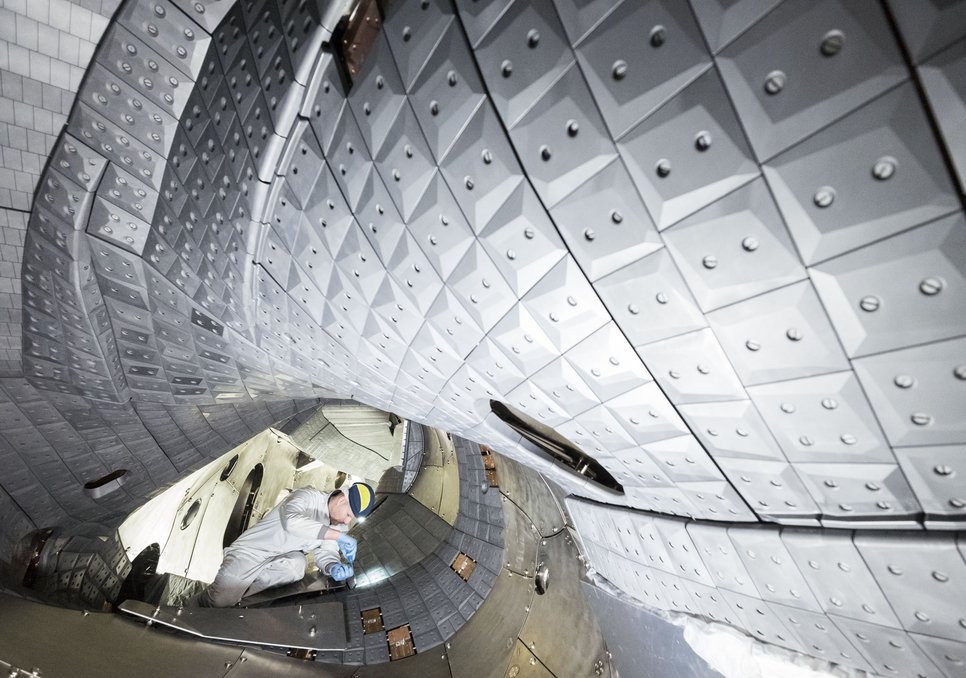The second experimentation phase
September until November 2017; Juli until Oktober 2018

Unlike in the first experimentation phase 2015/16, the plasma vessel of Wendelstein 7-X has been fitted with interior cladding since September 2017. The vessel walls are now covered with graphite tiles, thus allowing higher temperatures and longer plasma discharges. With the so-called divertor it is also possible to control the purity and density of the plasma: The divertor tiles follow the twisted contour of the plasma edge in the form of ten broad strips along the wall of the plasma vessel. In this way, they protect particularly the wall areas onto which the particles escaping from the edge of the plasma ring are made to impinge. Along with impurities, the impinging particles are here neutralised and pumped off.
First experience with the new wall elements were highly positive. While by the end of the first campaign pulse lengths of six seconds were being attained, plasmas lasting up to 26 seconds are now being produced. A heating energy of up to 75 megajoules could be fed into the plasma, this being 18 times as much as in the first operation phase without divertor. The heating power could also be increased, this being a prerequisite to high plasma density.
In this way a record value for the fusion product of stellarators was attained. This product of the ion temperature, plasma density and energy confinement time specifies how close one is getting to the reactor values needed to ignite a plasma. At an ion temperature of about 40 million degrees and a density of 0.8 x 1020 particles per cubic metre Wendelstein 7-X has attained a fusion product affording a good 6 x 1026 degrees x second per cubic metre, the world’s stellarator record. “This is an excellent value for a device of this size, achieved, moreover, under realistic conditions, i.e. at a high temperature of the plasma ions”, says Professor Sunn Pedersen. The energy confinement time attained, this being a measure of the quality of the thermal insulation of the magnetically confined plasma, indicates with an imposing 200 milliseconds that the numerical optimisation on which Wendelstein 7-X is based might work.
The fact that optimisation is taking effect not only in respect of the thermal insulation is testified to by the evaluation of experimental data from the first experimentation phase from December 2015 to March 2016 (see: Nature Physics, https://doi.org/10.1038/s41567-018-0141-9). This shows that also the bootstrap current behaves as expected. This electric current is induced by pressure differences in the plasma and could distort the tailored magnetic field. Particles from the plasma edge would then no longer impinge on the right area of the divertor. The bootstrap current in stellarators should therefore be kept as low as possible. Analysis has now confirmed that this has actually been accomplished in the optimised field geometry. “Thus, already during the first experimentation phase important aspects of the optimisation could be verified”, states first author Dr. Andreas Dinklage. “More exact and systematic evaluation will ensue in further experiments at much higher heating power and higher plasma pressure.”

After three months of experiments with the new equipment, the next round of upgrades began at the end of 2017; among other things, new measuring devices and heating systems were installed. The experiments were resumed from July 2018 onwards.
While the divertor had already demonstrated its good impact, the plasma values with help of the extended plasma heating and purified vessel walls could now be significantly increased. The newly installed neutral particle heating injects fast hydrogen atoms into the plasma, which transfer their energy to the plasma particles via collisions. The result was high plasma densities of up to 2 x 1020 particles per cubic meter – values that are sufficient for a future power station. At the same time, the ions and electrons of the hydrogen plasma reached an impressive temperature of 20 million degrees Celsius.
Record stellarator values achieved Wendelstein 7-X for the energy stored in the plasma. By strong microwave heating, the energy content of the plasma exceeded one megajoule for the first time, without the vessel wall becoming too hot. With good plasma values, long lasting plasmas over durations of 100 seconds have been obtained – also one of the best stellarator values to date.
The final experiments of this operation phase were conducted in mid-October 2018 followed by the next round of upgrades on Wendelstein 7-X. In order to be able to further increase the heating energy without overloading the vessel wall, the current graphite tiles of the divertor were replaced by water-cooled elements made of carbon fibre-reinforced carbon. Thus equipped, from 2022 onwards the researchers step by step work their way towards plasmas that last for 30 minutes. Then, it will remain to be seen whether Wendelstein 7-X can also fulfil its optimisation goals during continuous operation – the essential advantage of stellarators.

